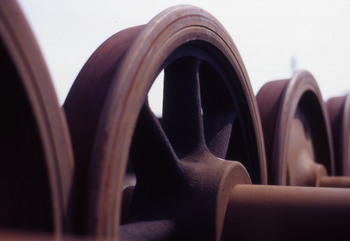Speed Lettering 07 - psychological explanations [Column_Letters & Figures]
 : How about spoke wheel?
: How about spoke wheel?Psychology explains the terms for the rise of such appearances;
1) A wedge-shaped objects
2) Oblique directions or positions
3) Shadows or gradations
An instance for 1) A wedge-shaped objects would be “streamlined” equipment.
Vanderbilt tenders and “speed lettering” would be an instance for 2) Oblique directions or positions.
Today’s color scheme of New Jersey Transit’s equipment would be an instance for 3) Shadows or gradations. How about the spoke wheel resembles the effect used in MANGA? Or, how about the steam and smoke of steam locomotives painted by the impressionists? I think these can be also classified as gradations.
The issue is that we cannot catch such an appearance objectively. We can’t scientifically extract the fact. Thus, the psychological explanations are built on hypothesis. It reminds me of the “terror tip”
Well, let’s have a talk quoting this explanation.
心理学では、斜体に覚えるようなみかけの運動が生じる(感じられる)要件として3件挙げている。
第一には「クサビ形(<、>字)の形体」である。
第二には「斜めの方向、位置」である。
第三には「表面の陰影やぼやけ」である。こうしたものから運動する感じが生じると記されている
(本明寛「造形心理学入門」1962、美術出版、p.150)
第一の「クサビ形」の例には、いわゆる流線型車両を挙げることができるだろう。いま考察している斜体による速度感は、第二の「斜めの方向」によるもののように思える。以前、Vanderbilt tenderに触れた際スピード感に言及したが、これもまた「斜めの方向」によるもののように思える。第三の「ぼやけ」は、粘着シートによる外装の普及とともに鉄道車両によく見るようになった。最近のNew Jersey Transitの車両外装は事例として挙げられるだろう。スポーク車輪のかたちも劇画的なボカシとよく似ている。印象派の画家たちが描く蒸気機関車のけむりはどうだろう。
さて、問題は、心理学ではみかけの運動が生じる仕組みの説明が困難なことである。その効果を量的に測定できない=客観的な仕掛けを用意できないので、深層を舞台とする仮説を示す他ないという。その仮説とは、例えば「認知の場に存在する方向のある緊張体系が、その方向への運動を助長し、それに反する方向への運動を妨害する」(同書、p.151)というものである。
クサビ形などの力動的な特性がもたらす心理的な働きによって、それとバランスをとろうとする生理的な働きがひとの心に生じる。この生理的な働きによる心の緊張が、みかけの運動を生じさせるという。尖端恐怖のような感覚だろうか?
2011-06-30 23:37
コメント(0)
トラックバック(0)




コメント 0